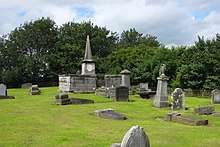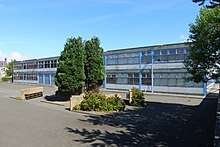Methil
| Methil | |
|---|---|
.jpg) East Wemyss and Methil from the air | |
 Methil Methil shown within Fife | |
| Population | 11,000 |
| OS grid reference | NT365995 |
| • Edinburgh | 45 miles (72 km) |
| Council area | |
| Country | Scotland |
| Sovereign state | United Kingdom |
| Post town | Leven |
| Postcode district | KY8 |
| Dialling code | 01333 |
| Police | Scottish |
| Fire | Scottish |
| Ambulance | Scottish |
| EU Parliament | Scotland |
| UK Parliament | |
| Scottish Parliament | |
Methil is an eastern coastal town in Scotland. It was part of the former Burgh of Buckhaven and Methil which existed between 1891 and the reorganisation of local government in 1975. It lies within a continuous urban area described as Levenmouth.
Methil lies geographically between Largo Bay to the east and Wemyss Bay to the west. Previously an industrial maritime powerhouse of the region and once Scotland's greatest coal port, it is now redirecting itself towards a green energy future. One boundary delineating Methil from its adjacent towns is the River Leven.
Overview


Prior to the Reformation when it was absorbed into the Parish of Wemyss, Methil was an independent parish centred on a church situated well inland in part of what is now Methilmill Cemetery.[1] In the 17th century, it developed as a coastal village, at first with a tidal harbour, which expanded very considerably around the start of the 20th century thanks to a boom in coal mining. From 1920 onwards, the development of (mainly) council housing caused the town to expand inland to meet up with the formerly separate village of Methilhill and reach the boundaries of Methilmill Cemetery and the site of the ancient parish church.[2]
Historically, the main employer in the area was coal mining, most of the coal being exported through Methil Docks, which exported over 3,000,000 tons per year for a while between the World Wars.[3] A related development around 1960 was Methil Power Station, sited at the mouth of the River Leven and demolished in 2011. This power station made good use of colliery slurry which otherwise would have gone to waste. Nearby is the new Bayview Stadium, home to league one side East Fife Football Club. Bayview Park had previously been located more centrally in the town, at the corner of Wellesley Road and Kirkland Road.[2]
Facilities
Methil Docks was particularly significant during World War II for the movement of coal and other resources. The docks had a hydraulic power station to serve the distinctive coal hoists, all of which were once local landmarks. The town was traversed by several railways linking the local collieries to the docks, one of which crossed the High Street on an overbridge. After the post-war nationalisation of the railways, the coal mines and the docks continued to be linked by the Wemyss Private Railway as well as by British Railways (which had replaced the LNER and the North British Railway).[4]
Now there is strong local pressure to reopen the railway line from Thornton Junction, which would arguably help both trade and improve public transport, including tourism for the whole area. The "Hydrogen Office" based in the docks aims to demonstrate the benefits of improved energy efficiency and renewable and hydrogen energy systems.[5]
Kirkland High School and Community College was a secondary education and combined education college. It was amalgamated with Buckhaven High School in August 2016 to form Levenmouth Academy, both of the older schools being demolished immediately thereafter. Primary schools in the area include Denbeath Primary, Aberhill Primary ('listed' as of architectural/historical interest and long outliving the 1950s and 1960s secondary school buildings)[6] and Methilhill Primary.
Local politics is controlled by Fife Council although there is interest being shown by some people in redeveloping more locally centred councils. Methilhill had a Community Council for a period of time, although it is not currently active.
There is a committee of Fife councillors elected to represent the area described by Fife Council as "Levenmouth" (which includes Methil and other nearby towns – although the description "Levenmouth" does not have a historical or otherwise substantive 'raison d'etre' as a nomenclature, it does provide for political expediency and accords favourably with current local civil service ease of operation).
References
- ↑ Taylor, Simon (2006). The Place-Names of Fife, Volume One - West Fife between Leven and Forth. 9781900289771: Shaun Tyas, Donington. pp. 593–595.
- 1 2 Smith, Ronald. "History of Methil".
- ↑ "Methil Docks". Methil Heritage. Retrieved 24 April 2016.
- ↑ Brotchie, A W (1998). The Wemyss Private Railway. The Oakwood Press. ISBN 9780853615279.
- ↑ "Home" The Hydrogen Office. Retrieved 6 December 2009.
- ↑ Historic Environment Scotland. "Aberhill Primary School".